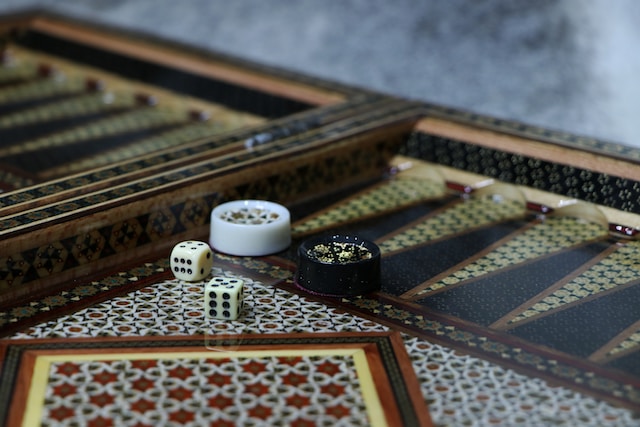Backgammon is one of the few games around today that has been enjoyed for millennia. Its enduring popularity and longevity speak volumes of its captivating nature, combining strategy and luck in a game that effortlessly brings people together. In this guide, we’ll take you through the rules of backgammon, giving you valuable insights along the way to help you achieve victory. In addition to explaining how to play backgammon, we’ll also guide you through some basic strategies and answer some frequently asked questions about the game. So, without further ado, let’s get started!
1. Getting Ready to Play
Familiarise Yourself with the Backgammon Board
To become a Backgammon master, it’s essential to learn more about the game and acquaint yourself with the layout of the board. The Backgammon board consists of 24 narrow triangles called points, arranged in four quadrants of six triangles each. These quadrants include the player’s home board and outer board, as well as the opponent’s home board and outer board. Players sit opposite each other, fostering a sense of competition and camaraderie. The home boards are located on the right quadrant closest to each player, and they serve as the starting point for the checkers. The players move their checkers counterclockwise in a horseshoe-like direction, aiming to bear them off the board before their opponent.
Setting Up the Board
Now that you understand the board’s layout, it’s time to set up the game. Each player starts with 15 checkers of two different colours, traditionally white and red or white and black. To begin, arrange your checkers as follows: two on your 24 point, five on your 13 point, three on your 8 point, and five more on your 6 point. This initial setup provides a balanced distribution of checkers across the board, setting the stage for strategic gameplay. Remember that each player has their own numbering system, so there won’t be any overlap of checkers, and it’s crucial to maintain consistency throughout the game.
Determine Who Goes First
Before the excitement of the game begins, the players must decide who will take the first turn. To do this, both players roll a single die. The player who rolls the higher number will go first and use the rolled numbers as their first moves. This simple yet essential step sets the tone for the rest of the game, as the first player gains a slight advantage by making the initial moves. If both players roll the same number, roll again to break the tie and determine the starting player.
Understanding the Doubling Cube
In Backgammon, there’s no scoring system like points; instead, the winner gains no points, while the loser loses points based on the face value of the stakes on the doubling cube. This cube, not a die, starts at 1 and can be doubled at any time during the game by the player who has the turn. The doubling cube adds an extra layer of strategy and excitement to the game, as players have the option to increase the stakes at pivotal moments. To double the stakes, a player must do so at the beginning of their turn, before rolling the dice. If the opponent accepts the double, the cube is turned and placed in their court, allowing them to propose a double in the future. However, if they decline, they forfeit the game and lose by the original stakes. The doubling can go back and forth, but it’s typically done only three or four times in a game, as excessive doubling can lead to significant point swings and unpredictable outcomes.
2. Moving Your Checkers
Understanding the Movement of Checkers
The movement of checkers in Backgammon is dictated by the roll of two dice. Players take turns rolling the dice and then move their checkers according to the numbers rolled. The roll of the dice represents two separate moves, one for each die. For example, if a player rolls a 4 and a 2, they can move one checker four points and another checker two points, or they can move one checker a total of six points if a space is unoccupied. The key is to plan your moves strategically to position your checkers optimally while impeding your opponent’s progress.
Hitting and Entering
One crucial aspect of Backgammon is hitting your opponent’s checkers to send them to the bar, a central ridge that divides the board. When a checker is hit, it must re-enter the game and move to an open point on your opponent’s home board during your turn. Failure to do so means losing your turn. Properly managing the re-entry of checkers can significantly impact the game’s outcome, making it a critical skill to develop.
Dealing with Doubles
Rolling doubles (both dice showing the same number) is an exciting and advantageous moment in Backgammon gameplay. When you roll doubles, you earn four moves of the rolled number. This allows for more extensive movement of your checkers, offering strategic opportunities to outmanoeuvre your opponent. Utilise these moves strategically by moving four checkers or a combination of two checkers multiple times. However, remember that rolling doubles is relatively rare, so make the most of this opportunity when it arises.
Keep Your Checkers Safe
One essential aspect of Backgammon is protecting your checkers from being hit by your opponent’s checkers. A single checker on a point is known as a blot and is vulnerable to being hit by your opponent, sending the hit checker to the bar. To avoid this setback, aim to have at least two checkers on a point, especially in the early stages of the game. Keeping multiple checkers on a point adds protection and makes it more challenging for your opponent to hit your checkers, allowing you to maintain a stronger position on the board.
Aim for Board Domination
Before venturing into your home court, focus on occupying as many points on the board as possible with two or three checkers. This approach provides several benefits, including creating more movement options, limiting your opponent’s movements, and increasing your chances of hitting their blots. A well-distributed presence of checkers across the board sets the stage for a powerful endgame, where you can efficiently bear off your checkers and secure victory. Balancing offense and defence in the early stages will help you gain control of the board and enhance your chances of success.
3. A More Detailed Look at Hitting and Entering
Hit Your Opponent’s Blot to the Bar
A crucial aspect of Backgammon strategy is hitting your opponent’s blots whenever possible. A blot is a single checker occupying a point, making it vulnerable to a hit. When you hit an opponent’s blot, their checker is sent to the bar, a central ridge that divides the middle of the board. The bar acts as a temporary holding area for hit checkers, preventing them from re-entering the game until the player successfully brings them back into their home board. Hitting your opponent’s blots is an effective way to slow down their progress and create opportunities for you to advance your checkers.
Enter Your Checkers from the Bar
If your checker is hit and placed on the bar, your task is to re-enter it into your opponent’s home board during your turn. To do this, roll the dice and move your checker onto an open point on your opponent’s home board if the rolled number allows it. If the number rolled does not correspond to an open point, you lose your turn and must try again on your next turn. Re-entering checkers from the bar is a critical part of the game, and successful execution can significantly impact the game’s outcome.
Moving Other Checkers After Re-entry
Once you successfully re-enter your checkers from the bar and place them in your opponent’s home board, you can continue moving your other checkers. If you have two checkers on the bar, both must be re-entered before any other checkers can be moved. However, if you can only re-enter one checker during a dice roll, you will have to wait until your next turn to try again. Efficiently managing your checkers’ re-entry can dictate the flow of the game, so plan your moves carefully to maintain control and apply pressure on your opponent.
4. Bearing Off Your Checkers
Understanding How to Win the Game
To secure victory in Backgammon, you must be the first player to bear off, or remove, all of your checkers from the board and place them into your tray. The first player to bear off all their checkers is declared the winner. Bearing off your checkers involves rolling the dice and moving them into your home court, where they can safely exit the board. The numbers rolled on the dice must precisely match the number of spaces needed to remove each checker from the board. The ultimate goal of the game is to skilfully navigate your checkers through the board to achieve a triumphant bearing off.
Move All Checkers into Your Home Court
Before bearing off your checkers, you must gather all of them into your home court. The home court comprises points 1 to 6 on your side of the board. Ensuring all your checkers are within your home court positions you for the final stage of the game—bearing them off. Keep in mind that your checkers remain vulnerable to hits while in your home court, so be cautious and strategic in your moves.
Initiating the Bearing Off Process
With your checkers safely assembled in your home court, it’s time to begin the bearing off process. When bearing off, you can only remove checkers from points that correspond to the numbers rolled on the dice. For example, if you roll a 4-1, you can bear off one checker from the 4th point and one from the 1st point, provided that you have checkers on those points. If you don’t have a checker on a rolled point, you can bear off a checker from the next highest point where you do have a checker. This process allows you to strategize and adapt your bearing off strategy based on the numbers rolled and the distribution of your checkers on the board.
Bearing Off Multiple Checkers
In some instances, the dice rolls may enable you to bear off multiple checkers at once. For example, if you roll double sixes and have four checkers on the 6th point, you can bear off all four checkers in a single move. Take advantage of these opportunities whenever possible, as efficiently bearing off your checkers can secure a swift and decisive victory.
Handling Lower Roll Prioritisation
Sometimes, you may have a higher number and a lower number to bear off, but you cannot bear off the higher number due to an obstacle on the board. In this situation, you must move a checker according to the lower number before bearing off the checker associated with the higher number. For instance, if you have a checker on the 5th point and roll a 5-1, you must first move the checker one point to the 4th point before bearing it off using the 5 value. This prioritization ensures that you make the most of your dice rolls and advance your bearing off process effectively.
Celebrating Your Victory
Congratulations! If you successfully bear off all fifteen of your checkers before your opponent does, you have emerged victorious in the game of Backgammon. However, it’s essential to understand that not all wins are equal. Depending on the state of the board and the checkers when you bear off, your opponent may lose differently:
- A Regular Loss: If you bear off all your checkers while your opponent is in the process of bearing off their checkers, they lose only the value on the doubling cube. This is the standard outcome of most games.
- The Gammon: If you bear off all your checkers while your opponent has not yet started bearing off any of theirs, they are gammoned and lose twice the value on the doubling cube. This reflects a more decisive victory.
- The Backgammon: If you bear off all your checkers while your opponent still has checkers on the bar or your home court, they are backgammoned and lose three times the value on the doubling cube. This is the most significant victory possible and demonstrates a dominant performance.
Playing Again and Setting Goals
Backgammon is designed for repeated play, making it ideal for friendly matches, tournaments, or casual gaming sessions. You can set goals for your games, such as playing until one player loses a certain number of points. Keeping a tally of points lost by each player allows for seamless continuation of the game in future sessions.
5. Common Backgammon Strategies
It goes without saying that favourable dice rolls give a player an advantage when playing backgammon, but with the game’s multiple rounds, the luck factor usually levels out. This is great news for players with a good understanding of basic strategies in backgammon, who can use their knowledge to get an edge on their opponents. Here are five effective backgammon strategies that will elevate your gameplay and help you to achieve victory:
The Running Game
The running game is the most straightforward backgammon strategy. It involves moving your checkers towards your home board as quickly as possible. If both players adopt this approach, the player with superior rolls will likely triumph. For this reason, committing to a running game is advisable only when you start with strong rolls. Beginners often favour this strategy, assuming higher rolls guarantee victory.
The Holding Game
Contrasting the running game, the holding game centres around maintaining an anchor point in your opponent’s home board. While advancing your furthest checkers early on can be wise to avoid being trapped, leaving an anchor point in your opponent’s home board offers two advantages. First, it provides a safe landing spot in case one of your checkers gets sent to the bar, preventing your opponent from priming you into an inevitable defeat. Second, the holding game allows your anchor to pose a threat to your opponent’s advancing checkers. Capturing a checker in your opponent’s home board and having them capture yours in response still puts you ahead in pips.
The Back Game
The back game takes the holding game to the next level by maintaining multiple made points on your opponent’s home board. This strategy comes into play when your checkers are repeatedly knocked onto the bar. The back game isn’t a deliberate approach but rather a way to salvage a game where you’re being dominated. Besides intensifying the offensive threat of the holding game, the back game also inconveniences your opponent by occupying valuable home board real estate.
The Blitz
The blitz strategy is an aggressive assault on your opponent’s vulnerable checkers. Instead of focusing on reaching your home board, the blitz aims to land on your opponent’s checkers whenever possible, sending them to the bar. This tactic not only sets your opponent back in terms of pips but may also trap their checkers on the bar if they fail to roll the right numbers to re-enter the board. However, be cautious when attacking close to your home row, as it may not significantly disadvantage your opponent while exposing your own checker to potential losses.
Priming
Priming is a fundamental backgammon strategy that involves building a “prime,” which is a connected series of made points along the board. Experts consider this approach essential when striving to win at backgammon. By forming a wall of four consecutive points, you obstruct your opponent’s progress unless they roll a five or six. This delay not only hampers your opponents but also provides safe points for your other advancing checkers. Combining the blitz with priming, known as the “two-way forward” attack, further hinders your opponent, resulting in many wasted dice rolls for them.
FAQs (Frequently Asked Questions)
What is The Object of the Game?
The primary objective in backgammon is to move all your checkers around the board into your home board and subsequently bear them off. Your home board refers to the area closest to your side of the board, and it is from here that you can remove your checkers from the game. The first player to successfully bear off all their checkers is declared the winner.
Is Backgammon a game of luck or skill?
Backgammon is a unique blend of luck and skill, making it a thrilling and dynamic board game. The initial dice rolls introduce an element of chance that can influence the course of the game. However, skilled players can strategically navigate the board, create advantageous positions, and capitalise on their opponents’ mistakes. While luck plays a role in the outcome, experienced players consistently outperform novices, showcasing the importance of skill in the game.
Can Backgammon be played online?
Yes, Backgammon is widely available as an online game, with numerous platforms and websites offering opportunities to play against computer opponents or real players from around the world. Online Backgammon provides convenience and accessibility, enabling players to enjoy the game anytime and anywhere.
What are the main Backgammon variants?
While the standard version of Backgammon is the most commonly played, several variants exist with slight rule differences. Some popular variants include:
- Hypergammon: Played on a smaller board with three checkers starting on each player’s 24 point.
- Nackgammon: Players start with only two checkers on their 24 point, making the initial setup challenging.
- LongGammon: A longer game that requires players to bear off all 15 checkers.
- Tavli: A Greek variant with different rules for bearing off and re-entering checkers.
Can I use Backgammon strategies in other board games?
Many of the strategic concepts used in Backgammon, such as blockades, timing, and assessing risk, are transferable to other board games. The ability to think several moves ahead, adapt to changing circumstances, and manage resources effectively are valuable skills applicable to a wide range of games and even real-life decision-making scenarios.
Is Backgammon suitable for all ages?
Absolutely! Backgammon’s simple yet strategic gameplay makes it suitable for players of all ages. Younger players can enjoy the game’s excitement and chance elements, while more experienced players can delve into its deeper strategies. It’s an excellent way to bring friends and family together for hours of fun and friendly competition.




